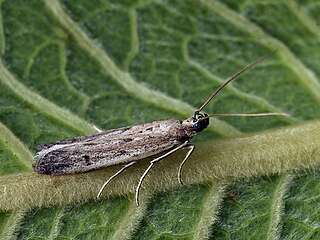
Apamea remissa, the dusky brocade, is a species of moth of the family Noctuidae. It is distributed throughout Europe and Turkey, ranging across the Palearctic realm to Siberia, Manchuria and Japan. It has also been reported from Alaska.

Acrobasis consociella is a moth of the family Pyralidae. It is found in Europe.

Dioryctria abietella is a moth of the family Pyralidae. It is found in Europe.

Ephestia elutella, the cacao moth, tobacco moth or warehouse moth, is a small moth of the family Pyralidae. It is probably native to Europe, but has been transported widely, even to Australia. A subspecies is E. e. pterogrisella.

Oncocera semirubella, the rosy-striped knot-horn, is a small moth of the family Pyralidae.

Pempelia palumbella is a moth of the family Pyralidae. It is found in Europe.

The Viper's Bugloss(Hadena irregularis) is a species of moth of the family Noctuidae. It is found in Europe.

Nephopterix angustella is a moth of the family Pyralidae described by Jacob Hübner in 1796. It is found in Europe.

Homoeosoma nebulella, the Eurasian sunflower moth, is a moth of the family Pyralidae. It is found in Europe, Russia, Anatolia, the Middle East and West Africa. The wingspan is 20–27 mm.The forewings are pale whitish ochreous, tinged with grey and sprinkled with dark grey, towards costa suffused with whitish ; first line indicated by two blackish dots, upper more remote from base; second faintly darker-edged, usually preceded by a dark fuscous subdorsal dot; two blackish transversely placed discal dots. The hindwings are subhyaline, fuscous-tinged, the veins and termen fuscous. Larva dull greenish-yellow dorsal and broader subdorsal lines dull purple; spiracular interrupted, double, dull purple; head brown: in flower-heads of Carduus

Pyla fusca is a snout moth of the subfamily Phycitinae and inhabits the Holarctic. It is distinct from the other species of the genus Pyla, which are only found in North America, and has been proposed for separation in a monotypic genus Matilella. Considering the insufficient knowledge of Phycitinae, this may be warranted, and eventually relatives of this specimens might be discovered in the Old World, or it might turn out to be a cryptic species complex. On the other hand, its separation might render Pyla paraphyletic, in which case it would not be warranted. More research is required to resolve this question.

Euzophera pinguis, the tabby knot-horn, is a moth of the family Pyralidae. It was described by Adrian Hardy Haworth in 1811 and is found in Europe.

Scoparia pyralella, the meadow grey, is a species of moth of the family Crambidae. It was first described by Michael Denis and Ignaz Schiffermüller in 1775.

Homoeosoma nimbella is a moth of the family Pyralidae. It is found in Europe.

Pempeliella ornatella is a moth of the family Pyralidae described by Michael Denis and Ignaz Schiffermüller in 1775. It is found in most of Europe, east to the Ural, Siberia, central Yakutia and Kyrgyzstan.
Platyptilia isoterma is a moth of the family Pterophoridae. It is found in New Zealand.

Caryocolum marmorea is a moth of the family Gelechiidae. It is found from Scandinavia to the Mediterranean islands, and from Ireland to Poland, Hungary and Greece. It is also found on the Canary Islands and Madeira. It is also found in North America.

Cryptoblabes bistriga is a species of snout moth in the genus Cryptoblabes. It was described by Adrian Hardy Haworth in 1811. It is found in most of Europe, except Portugal, parts of the Balkan Peninsula and Ukraine.

Acrobasis advenella is a species of snout moth in the genus Acrobasis. It was described by Johann Zincken in 1818 and is found in most of Europe. They have an oligophagous diet primarily feeding on plants from the Rosaceae family including the black chokeberry. They cause significant damage to organic chokeberry farming, due to their widespread impact on the quality and quantity of the black chokeberry plants.

Delplanqueia dilutella is a species of moth in the family Pyralidae. It was described by Michael Denis and Ignaz Schiffermüller in 1775. It is found in most of Europe, east to Russia, Turkey, Iran and Mongolia.

Phycitodes binaevella is a species of snout moth described by Jacob Hübner in 1813. It is found in most of Europe, Asia Minor, Lebanon and the Palestinian Territories.


















